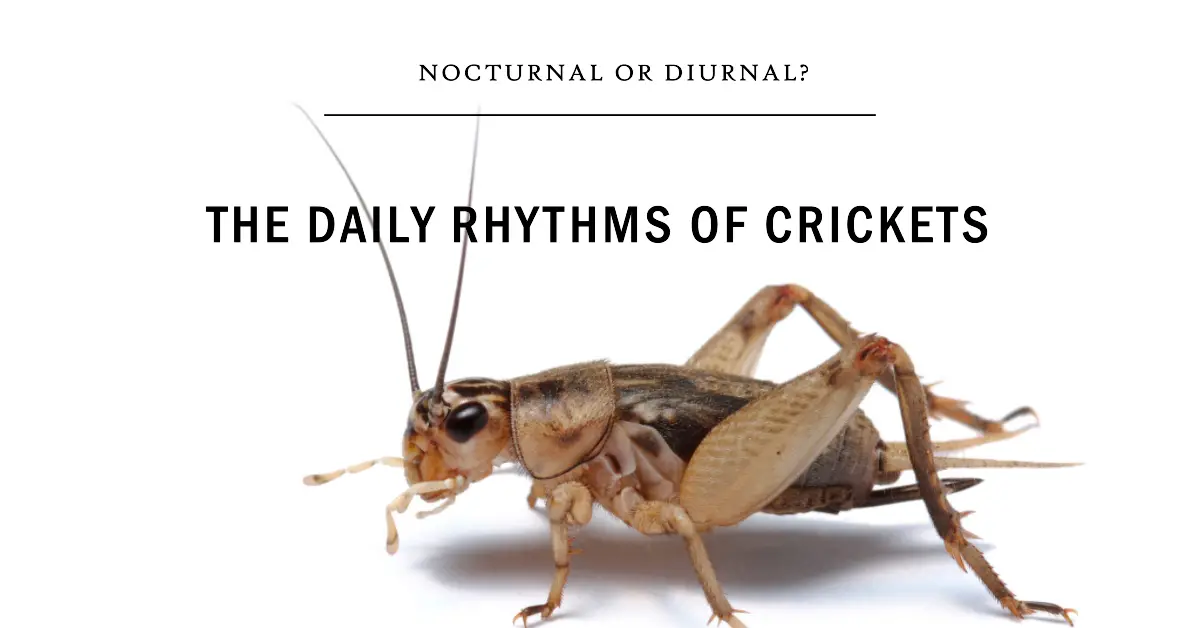
Jeffery Jago is a expert in horticulture and worm breeding. With a background in plant cultivation
Last Updated on March 26, 2023 by Jeffery Jago
Crickets are fascinating insects that have been a subject of interest for centuries due to their captivating chirping sounds and unique behaviors.
Understanding cricket behavior not only helps us appreciate these remarkable creatures but also aids in ecological preservation and pest management efforts.
One of the most common questions about crickets is whether they are nocturnal or diurnal. In this article, we will delve into the daily rhythms of crickets to answer this question.

The Nature of Crickets: Nocturnal vs. Diurnal
Nocturnal animals are those that are active during the night, while diurnal animals are active during daylight hours. In general, crickets are classified as nocturnal insects, which means that they are predominantly active during the night.
This nighttime activity helps crickets avoid predators, extreme temperatures, and desiccation.
Crickets are part of the insect order Orthoptera, which also includes grasshoppers and katydids. While some Orthopteran species are diurnal, such as some grasshoppers and crickets, most of them are nocturnal.
Being nocturnal, crickets have adapted to live in dark environments and are capable of navigating and finding food sources in low light conditions.
They have evolved specialized structures that allow them to make chirping sounds to communicate with each other.
This communication is vital for mating, defending territories, and warning others of potential danger. Male crickets produce chirping sounds by rubbing their wings together, while females respond with their own chirps.
Another adaptation of nocturnal crickets is their ability to avoid predators. Their natural camouflage, along with their nocturnal activity, makes them difficult to spot by predators such as birds, rodents, and other insects that are active during daylight hours.
Some cricket species also use chemical defenses, producing toxins or strong-smelling secretions to deter predators.
Nocturnal activity also helps crickets avoid extreme temperatures and desiccation. During the day, temperatures can become too high for crickets to survive, so they hide in cool, shady areas such as under leaves, rocks, or in burrows.
At night, when temperatures drop, they become more active and move around to find food and mates.
In summary, the nocturnal nature of crickets is a crucial adaptation that allows them to avoid predators, extreme temperatures, and desiccation. It also allows them to communicate with each other, find food sources, and mate.
Circadian Rhythms and Crickets
Circadian rhythms are biological processes that follow a 24-hour cycle, influencing sleep and wake patterns in both animals and humans.
These rhythms play a significant role in determining the daily behaviors of crickets. Factors such as light, temperature, and humidity have a strong influence on cricket circadian rhythms, ultimately determining their daily patterns of activity.
Cricket Activity and Chirping Patterns
During the night, crickets exhibit various behaviors such as foraging for food, mating, and communicating with one another through their signature chirping sounds.
These sounds are produced by males rubbing their wings together to attract females for mating. Cricket activity is generally reduced during the day, primarily due to increased predation risk and unfavorable environmental conditions.
Exceptions to the Rule: Diurnal Cricket Species
Although most cricket species are nocturnal, there are a few exceptions. Some species, like the diurnal ground cricket, are active during the day.
These diurnal crickets exhibit unique adaptations and behaviors that allow them to thrive in daylight conditions, including different coloration and communication strategies to avoid predators.
Diurnal crickets, such as the ground cricket (Nemobius sylvestris), have adapted to be active during daylight hours to take advantage of food sources and resources that may not be available at night.
These crickets are typically found in open grasslands and meadows where they can bask in the sun and forage for food.
One key adaptation of diurnal crickets is their coloration. Unlike their nocturnal counterparts, diurnal crickets are often brightly colored with patterns and markings that blend in with their surroundings.
This allows them to avoid detection by predators such as birds and lizards that are active during the day.
Diurnal crickets also use different communication strategies than nocturnal crickets. While nocturnal crickets produce chirping sounds to communicate, diurnal crickets rely more on visual cues such as body posture and movement.
For example, male ground crickets may display their wings or antennae to signal to females or to intimidate other males.
Another advantage of being diurnal is the ability to locate potential mates and defend territories during daylight hours. This may be especially important in areas where there is competition from other species of insects that are active at night.
Impact of Human Activities on Cricket Behavior
Human activities, such as the use of artificial light sources, can significantly impact the natural activity patterns of crickets.
For example, exposure to artificial light at night can disrupt the circadian rhythms of crickets, altering their normal behaviors and potentially causing adverse effects on their populations.
This highlights the importance of understanding how human-induced changes can impact cricket behavior and the wider ecosystem.
Artificial light at night can have a significant impact on the behavior of nocturnal crickets. Light pollution can alter the timing of their activity, reducing their overall activity levels or causing them to become more active at unusual times.
This can have knock-on effects on the ecosystem as a whole, disrupting the normal interactions between different species of animals and plants.
For example, female crickets may be less receptive to mating calls from males who are affected by light pollution, leading to a reduction in the number of offspring produced.
This can have a knock-on effect on other species that rely on crickets as a food source, such as bats and birds.
Additionally, artificial light can disrupt the natural behavior of crickets that use the moon and stars to navigate.
This can cause them to become disoriented and potentially lose their way, leading to increased predation and mortality rates.
Human activities that alter the natural habitats of crickets can also impact their behavior. For example, deforestation or urbanization can lead to a reduction in suitable habitats, forcing crickets to adapt to new environments or migrate to new areas.
This can cause changes in their behavior, such as altered mating calls or changes in the timing of their activity.
Overall, it is crucial to understand how human-induced changes can impact cricket behavior and the wider ecosystem.
By studying the effects of light pollution and other forms of human activity on cricket behavior, we can develop strategies to minimize these impacts and preserve the natural rhythms of these important insects.
Conclusion
In conclusion, crickets are predominantly nocturnal insects, with their daily rhythms governed by circadian processes influenced by factors like light and temperature.
Although there are some diurnal cricket species, they are the exception rather than the rule. Understanding cricket behavior is essential for ecological preservation and pest management, and further research into cricket activity patterns and adaptations can provide valuable insights into these fascinating creatures.

